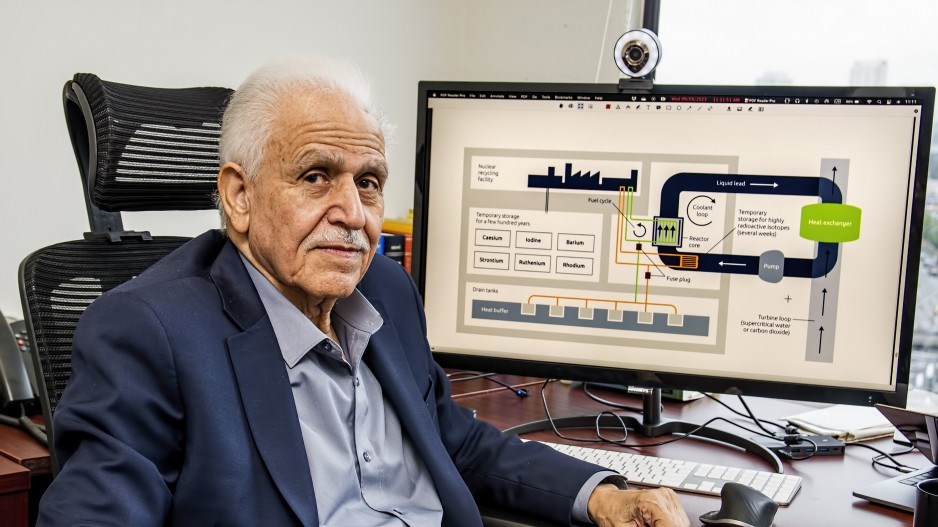With an official ban on nuclear power and uranium mining and exploration, British Columbia might seem like the last place in the world that German scientists would choose to start a new nuclear power company.
After all, in Canada most of the expertise in nuclear energy is in Ontario, where the CANDU reactor was developed and where several nuclear power plants operate.
Vancouver does have one powerful magnet, however, when it comes to attracting nuclear physicists – the TRIUMF National Laboratory at the University of BC. And one of the co-founders of Dual Fluid Energy says that, despite British Columbia’s anti-nuclear policies, Germany is even worse.
“Germany is broadly more anti-nuclear than British Columbia,” said Ahmed Hussein, chief research officer and co-founder of Dual Fluid Energy.
Under presser from the Green Party, Germany has been shutting down all of its nuclear power plants.
“In Canada, in general, nuclear power in Canada is more acceptable and has no popular resistance the way it is in Germany and many other countries,” Hussein said.
“The Canadian government appreciates and promotes nuclear power as a technology of the future,” Dual Fluid Energy states on its website.
“Most of the population sees nuclear power as an opportunity, and the country is very experienced in nuclear technology. Last but not least, there is also an internationally recognized nuclear licensing authority. In short, everything we need is there.”
As for why the company chose Vancouver, Hussein said it’s simple – he lives here. Hussein is one of five co-inventors; the other four are German scientists, and to date all of the financing has come from German investors.
Hussein is a physics professor emeritus at the University of Northern BC. He has also been a researcher at the TRIUMF lab in Vancouver and the Los Alamos National Laboratory in the U.S.
Götz Ruprecht, Dual Fluid’s CEO, is also a research associate at the TRIUMF National Laboratory. Armin Huke, chairman of the board, is the managing director of the Institute for Solid-State Nuclear Physics in Berlin.
“It made sense to us to be here in Vancouver so that I can be here and my position with TRIUMF will help us also for break-through studies,” Hussein told BIV News.
Kathryn Hayashi, CEO of TRIUMF Innovations, is happy to see innovators like Dual Fluid setting up in Vancouver and working with TRIUMF.
“We’re all trying to figure out how to address climate change,” she said. “We’re all trying to find net zero solutions, so we think it’s great that people are approaching it from different angles.
“I think it’s really exciting. Even a few years ago, nuclear wasn’t considered part of the clean energy equation, but that has changed.”
Dual Fluid’s approach is radically different from other models for generating nuclear power. It has elements of a fast breeder reactor and a molten salt reactor, although the “fluids” used are not molten salt but molten metals, and the reactor would operate at higher temperatures than most other nuclear power plants.
Conventional thermal reactors actually use very little of the fissile material (uranium), which is contained in fuel rods. Much of the fuel ends up wasted, and this leftover spent fuel is radioactive for thousands of years.
Fast reactors wring more energy out of the fuel, whether it is uranium or thorium, leaving less waste and with a much shorter radioactive life.
Dual Fluid’s proposed model is still very much experimental and early stage. More experimentation and testing will need to be done to get it to the prototype stage. One of the experiments to be done is testing materials at the TRIUMF particle accelerator to see how they will stand up to radiation.
One of the “fluids” that Dual Fluid would use is uranium and chromium – the fuel. The other fluid is molten lead. That’s the “coolant.”
Like a fast breeder reactor, the Dual Fluid approach would maximize the fission from the fissile material, which would mean more energy and less waste, which would also have a shorter radioactive life.
“The idea of a fast reactor has been around for a very, very long time,” Hussein said. “But they are not really used mainly for power.”
Dual Fluid’s approach is to operate at higher temperatures than conventional reactors.
“Instead of fuel rods, Dual Fluid uses two circulating fluids: One contains the fuel and the other extracts the heat,” the company explains. “The nuclear fuel can unleash its entire potential at 1000° Celsius. This offers an entirely new dimension in terms of performance and efficiency.”
Once the company has done all the necessary testing and experimentation, Hussein said the company plans to build a small prototype. He said it will likely be built somewhere that has shorter permitting timelines.




